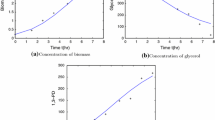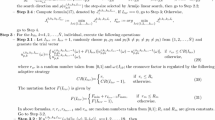Abstract
This paper considers the microbial batch culture process for producing 1,3-propanediol (1,3-PD) via glycerol fermentation. Our goal was to design an optimal control scheme for this process, with the aim of balancing two (perhaps competing) objectives: (i) the process should yield a sufficiently high concentration of 1,3-PD at the terminal time and (ii) the process should be robust with respect to changes in various uncertain system parameters. Accordingly, we pose an optimal control problem, in which both process yield and process sensitivity are considered in the objective function. The control variables in this problem are the terminal time of the batch culture process and the initial concentrations of biomass and glycerol in the batch reactor. By performing a time-scaling transformation and introducing an auxiliary dynamic system to calculate process sensitivity, we obtain an equivalent optimal control problem in standard form. We then develop a particle swarm optimization algorithm for solving this equivalent problem. Finally, we explore the trade-off between process efficiency and process robustness via numerical simulations.



Similar content being viewed by others
References
Biebl, H., Menzel, K., Zeng, A.P., Deckwer, W.D.: Microbial production of 1,3-propanediol. Appl. Microbiol. Biot. 52, 289–297 (1999)
Gtinzel, B.: Mikrobielle herstellung von 1,3-propandiol durch clostridium butyricum und adsorptive abtremutng von diolen. Ph.D. Dissertation, TU Braunschweig, Germany (1991)
Sun, Y.Q., Qi, W.T., Teng, H., Xiu, Z.L., Zeng, A.P.: Mathematical modeling of glycerol fermentation by Klebsiella pneumoniae: concerning enzyme-catalytic reductive pathway and transport of glycerol and 1,3-propanediol across cell membrane. Biochem. Eng. J. 38, 22–32 (2008)
Gao, C.X., Wang, Z.T., Feng, E.M., Xiu, Z.L.: Parameter identification and optimization of process for bio-dissimilation of glycerol to 1,3-propanediol in batch culture. J. Dalian Univ. Technol. 46, 771–774 (2006)
Li, X.H., Feng, E.M., Xiu, Z.L.: Optimal control and property of nonlinear dynamic system for microorganism in batch culture. Oper. Res. Trans. 9, 89–96 (2005)
Wang, L., Feng, E.M., Ye, J.X., Xiu, Z.L.: An improved model for multistage simulation of glycerol fermentation in batch culture and its parameter identification. Nonlinear Anal. Hybrid Syst. 3, 455–462 (2009)
Zeng, A.P., Rose, A., Biebl, H.: Multiple product inhibition and growth modeling of Clostridium butyricum and Klebsiella pneumonia in fermentation. Biotechnol. Bioeng. 44, 902–911 (1994)
Zeng, A.P., Biebl, H.: Bulk-chemicals from biotechnology: the case of microbial production of 1,3-propanediol and the new trends. Adv. Biochem. Eng. Biot. 74, 237–433 (2002)
Gong, Z.H., Liu, C.Y., Feng, E.M., Zhang, Q.R.: Computational method for inferring objective function of glycerol metabolism in Klebsiella pneumonia. Comput. Biol. Chem. 33, 1–6 (2008)
Zhang, Q.R., Xiu, Z.L.: Metabolic pathway analysis of glycerol metabolism in Klebsiella pneumonia incorporating oxygen regulatory system. Biotechnol. Progr. 25, 103–115 (2009)
Wang, L.: Determining the transport mechanism of an enzyme-catalytic complex metabolic network based on biological robustness. Bioproc. Biosyst. Eng. 36, 433–441 (2013)
Yuan, J.L., Zhang, X., Zhu, X., Feng, E.M., Xiu, Z.L., Yin, H.C.: Modeling and pathway identification involving the transport mechanism of a complex metabolic system in batch culture. Commun. Nonlinear Sci. Numer. Simul. 19, 2088–2103 (2014)
Yuan, J.L., Zhu, X., Zhang, X., Feng, E.M., Xiu, Z.L., Yin, H.C.: Robust identification of enzymatic nonlinear dynamical systems for 1,3-propanediol transport mechanisms in microbial batch culture. Appl. Math. Comput. 232, 150–163 (2014)
Wang, J., Sun, Q.Y., Feng, E.M.: Modeling and properties of a nonlinear autonomous switching system in fed-batch culture of glycerol. Commun. Nonlinear Sci. Numer. Simul. 17, 4446–4454 (2012)
Zeng, A.P., Deckwer, W.D.: A kinetic model for substrate and energy consumption of microbial growth under substrate-sufficient conditions. Biotechnol. Progr. 11, 71–79 (1995)
Gao, C.X., Feng, E.M., Wang, Z.T., Xiu, Z.L.: Parameters identification problem of the nonlinear dynamical system in microbial continuous cultures. Appl. Math. Comput. 169, 476–484 (2005)
Xiu, Z.L., Zeng, A.P., An, L.J.: Mathematical modeling of kinetics and research on multiplicity of glycerol bioconversion to 1,3-propanediol. J. Dalian Univ. Technol. 40, 428–433 (2000)
Liu, C.Y.: Sensitivity analysis and parameter identification for a nonlinear time-delay system in microbial fed-batch process. Appl. Math. Model. 38, 1449–1463 (2014)
Liu, C.Y.: Modeling and parameter identification for a nonlinear time-delay system in microbial batch fermentation. Appl. Math. Model. 37, 6899–6908 (2013)
Wang, G., Feng, E.M., Xiu, Z.L.: Vector measure for explicit nonlinear impulsive system of glycerol bioconversion in fed-batch cultures and its parameter identification. Appl. Math. Comput. 188, 1151–1160 (2007)
Rehbock, V., Teo, K.L., Jennings, L.S.: A computational procedure for suboptimal robust controls. Dynam. Control 2, 331–348 (1992)
Wei, W., Teo, K.L., Zhan, Z.: A numerical method for an optimal control problem with minimum sensitivity on coefficient variation. Appl. Math. Comput. 218, 1180–1190 (2011)
Loxton, R.C., Teo, K.L., Rehbock, V.: Robust suboptimal control of nonlinear systems. Appl. Math. Comput. 217, 6566–6576 (2011)
Loxton, R.C., Teo, K.L., Rehbock, V., Yiu, K.F.C.: Optimal control problems with a continuous inequality constraint on the state and the control. Autom. J. IFAC 45, 2250–2257 (2009)
Loxton, R.C., Teo, K.L., Rehbock, V., Ling, W.K.: Optimal switching instants for a switched-capacitor DC/DC power converter. Autom. J. IFAC 45, 973–980 (2009)
Loxton, R.C., Teo, K.L., Rehbock, V.: Optimal control problems with multiple characteristic time points in the objective and constraints. Autom. J. IFAC 44, 2923–2929 (2008)
Gao, C.X., Wang, Z.T., Feng, E.M., Xiu, Z.L.: Nonlinear dynamical systems of bio-dissimilation of glycerol to 1,3-propanediol and their optimal controls. J. Ind. Manag. Optim. 1, 377–388 (2005)
Wang, L., Feng, E.M., Xiu, Z.L.: Modeling nonlinear stochastic kinetic system and stochastic optimal control of microbial bioconversion process in batch culture. Nonlinear Anal. Model. Control 18, 99–111 (2013)
Chai, Q., Loxton, R., Teo, K.L., Yang, C.: A unified parameter identification method for nonlinear time-delay systems. J. Ind. Manag. Optim. 9, 471–486 (2013)
Lin, Q., Loxton, R., Teo, K.L.: The control parameterization method for nonlinear optimal control: a survey. J. Ind. Manag. Optim. 10, 275–309 (2014)
Liu, C.Y., Loxton, R., Teo, K.L.: Optimal parameter selection for nonlinear multistage systems with time-delays. Comput. Optim. Appl. (2014). doi:10.1007/s10589-013-9632-x
Lin, Q., Loxton, R.C., Xu, C., Teo, K.L.: State-delay estimation for nonlinear systems using inexact output data. In: Proceedings of the Chinese Control Conference, July 2014
Gao, W.F., Liu, S.Y., Huang, L.L.: Particle swarm optimization with chaotic opposition-based population initialization and stochastic search technique. Commun. Nonlinear Sci. Numer. Simul. 17, 4316–4327 (2012)
Gandomi, A.H., Yun, G.J., Yang, X.S., Talatahari, S.: Chaos-enhanced accelerated particle swarm optimization. Commun. Nonlinear Sci. Numer. Simul. 18, 327–340 (2013)
Zhang, J., Zhang, C., Chu, T., Perc, M.: Resolution of the stochastic strategy spatial prisoner’s dilemma by means of particle swarm optimization. PLoS One 6, e21787 (2011)
Ma, G., Zhou, W., Chang, X.L.: A novel particle swarm optimization algorithm based on particle migration. Appl. Math. Comput. 218, 6620–6626 (2012)
Kennedy J., Eberhart R.: Particle swarm optimization. In: Proceedings of the IEEE International Conference on Neural Networks, Nov–Dec 1995
Acknowledgments
This work was supported by the National Natural Science Foundation of China (Grant Nos. 11171050, 11101262, and 11371164) and the National Natural Science Foundation for the Youth of China (Grant Nos. 11301081, 11401073).
Author information
Authors and Affiliations
Corresponding author
Additional information
Communicated by Mimmo Iannelli.
Appendix
Appendix
The explicit formulas for the derivatives of \(\tilde{\mu }\) in (20)–(21) are given below.
The explicit formulas for the derivatives of \(\tilde{q}_2\) in (20)–(21) are given below.
The explicit formulas for the derivatives of \(\tilde{q}_i\), \(i=3,4,5\), in (20)–(21) are given below.
Rights and permissions
About this article
Cite this article
Cheng, G., Wang, L., Loxton, R. et al. Robust Optimal Control of a Microbial Batch Culture Process. J Optim Theory Appl 167, 342–362 (2015). https://doi.org/10.1007/s10957-014-0654-z
Received:
Accepted:
Published:
Issue Date:
DOI: https://doi.org/10.1007/s10957-014-0654-z




